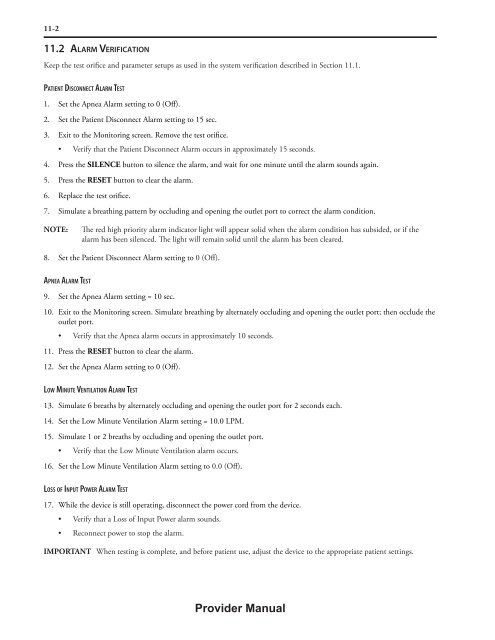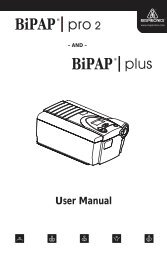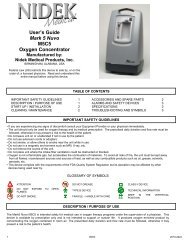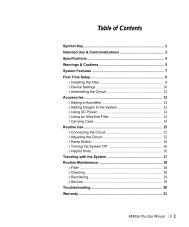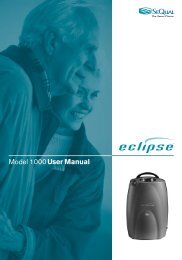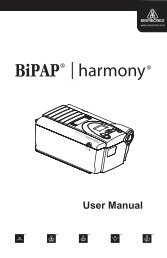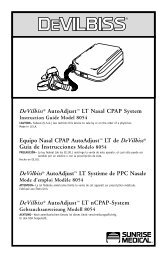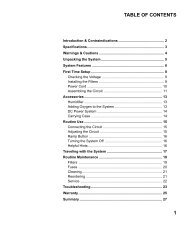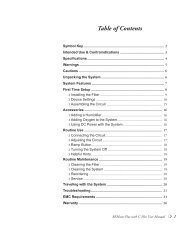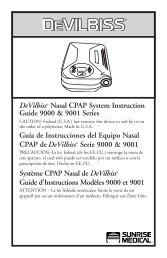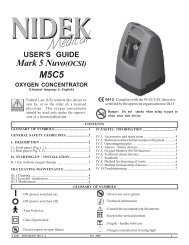Respironics BIPAP Auto SV - Impact Biomedical Corp.
Respironics BIPAP Auto SV - Impact Biomedical Corp.
Respironics BIPAP Auto SV - Impact Biomedical Corp.
You also want an ePaper? Increase the reach of your titles
YUMPU automatically turns print PDFs into web optimized ePapers that Google loves.
11-2<br />
11.2 Alarm Verification<br />
Keep the test orifice and parameter setups as used in the system verification described in Section 11.1.<br />
Patient Disconnect Alarm Test<br />
1. Set the Apnea Alarm setting to 0 (Off).<br />
2. Set the Patient Disconnect Alarm setting to 15 sec.<br />
3. Exit to the Monitoring screen. Remove the test orifice.<br />
• Verify that the Patient Disconnect Alarm occurs in approximately 15 seconds.<br />
4. Press the SILENCE button to silence the alarm, and wait for one minute until the alarm sounds again.<br />
5. Press the RESET button to clear the alarm.<br />
6. Replace the test orifice.<br />
7. Simulate a breathing pattern by occluding and opening the outlet port to correct the alarm condition.<br />
NOTE:<br />
The red high priority alarm indicator light will appear solid when the alarm condition has subsided, or if the<br />
alarm has been silenced. The light will remain solid until the alarm has been cleared.<br />
8. Set the Patient Disconnect Alarm setting to 0 (Off).<br />
Apnea Alarm Test<br />
9. Set the Apnea Alarm setting = 10 sec.<br />
10. Exit to the Monitoring screen. Simulate breathing by alternately occluding and opening the outlet port; then occlude the<br />
outlet port.<br />
• Verify that the Apnea alarm occurs in approximately 10 seconds.<br />
11. Press the RESET button to clear the alarm.<br />
12. Set the Apnea Alarm setting to 0 (Off).<br />
Low Minute Ventilation Alarm Test<br />
13. Simulate 6 breaths by alternately occluding and opening the outlet port for 2 seconds each.<br />
14. Set the Low Minute Ventilation Alarm setting = 10.0 LPM.<br />
15. Simulate 1 or 2 breaths by occluding and opening the outlet port.<br />
• Verify that the Low Minute Ventilation alarm occurs.<br />
16. Set the Low Minute Ventilation Alarm setting to 0.0 (Off).<br />
Loss of Input Power Alarm Test<br />
17. While the device is still operating, disconnect the power cord from the device.<br />
• Verify that a Loss of Input Power alarm sounds.<br />
• Reconnect power to stop the alarm.<br />
IMPORTANT When testing is complete, and before patient use, adjust the device to the appropriate patient settings.<br />
Provider Manual


